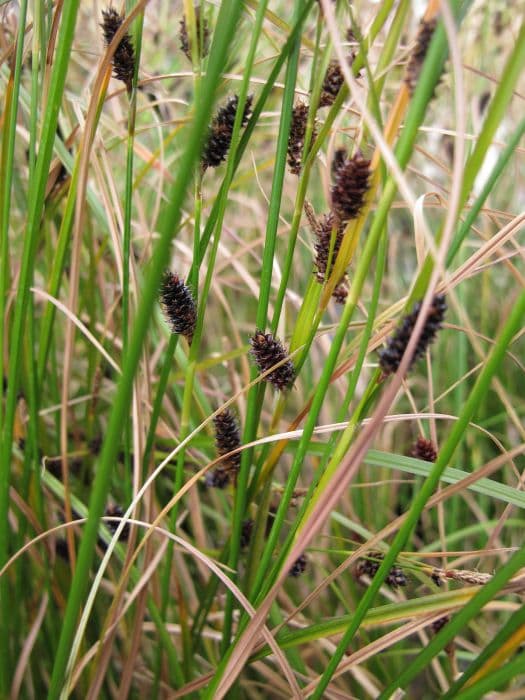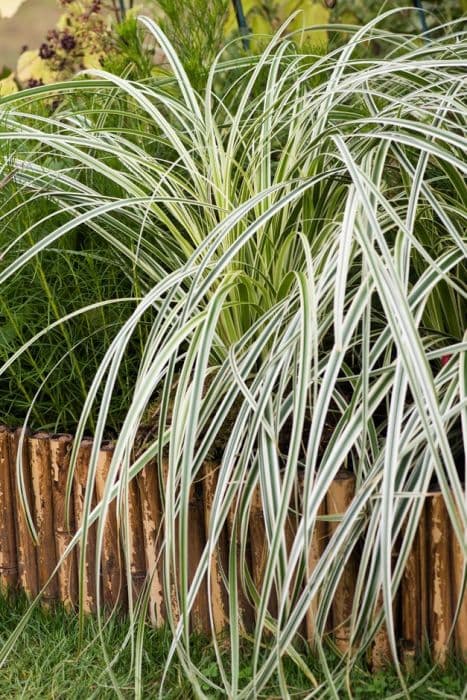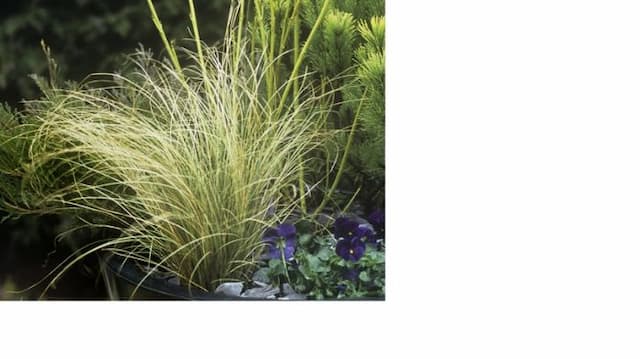Ice Dance Sedge Carex 'Ice Dance' (v)

ABOUT
Ice Dance is recognized for its graceful, arching foliage, characterized by a bright, creamy-white stripe running along the edge of each leaf, paired with a deep green center. This variegation creates a lively and attractive contrast, making it a distinctive addition to any garden space. The leaves themselves are long and slender, forming a dense, tufted habit. Moreover, the plant produces delicate, inconspicuous flower spikes, but it's primarily grown for its eye-catching leaves that keep the garden looking vibrant throughout the year. Its evergreen nature ensures that the attractive foliage can be appreciated even in the colder months, offering a constant splash of color to the landscape.
About this plant
 Names
NamesFamily
Cyperaceae
Synonyms
Ice Dance Sedge, Japanese Sedge Ice Dance, Variegated Sedge, Ice Dance Japanese Sedge
Common names
Carex 'Ice Dance'
 Toxicity
ToxicityTo humans
The Ice Dance Sedge is generally not considered toxic to humans. Therefore, ingestion of this plant typically does not lead to poisoning or adverse health effects.
To pets
The Ice Dance Sedge is not known to be toxic to pets. It is not associated with symptoms of poisoning, and ingesting this plant should not result in any harmful consequences for animals.
 Characteristics
CharacteristicsLife cycle
Perennials
Foliage type
Evergreen
Color of leaves
Variegated
Height
1-2 feet (30-60 cm)
Spread
1-2 feet (30-60 cm)
Plant type
Sedge
Hardiness zones
5
Native area
Japan
Benefits
 General Benefits
General Benefits- Low maintenance: Carex 'Ice Dance' is an easy-to-care-for plant that requires minimal upkeep once established.
- Shade tolerance: It thrives well in partially shaded areas of the garden where other plants may struggle.
- Soil adaptability: This sedge can adapt to a variety of soil types, though it prefers moist, well-draining soils.
- Ground cover: Its dense growth habit makes it an excellent choice for filling in bare spots and suppressing weeds.
- Year-round interest: With its evergreen foliage, 'Ice Dance' provides visual interest throughout all seasons.
- Erosion control: Its root system helps stabilize soil on slopes, preventing erosion.
- Attractive foliage: The variegated leaves with creamy margins add a decorative touch to the landscape.
- Wildlife habitat: Offers shelter and sometimes food for small wildlife and beneficial insects.
- Drought tolerance: Once established, it can tolerate periods of dryness, though it performs best with consistent moisture.
- Versatility in landscaping: Suitable for borders, woodland gardens, container planting, and as an understory plant.
 Medical Properties
Medical PropertiesThis plant is not used for medical purposes.
 Air-purifying Qualities
Air-purifying QualitiesThis plant is not specifically known for air purifying qualities.
 Other Uses
Other Uses- Artistic Displays: The variegated foliage of Ice Dance can be used to add texture and color contrast in floral arrangements and botanical art projects.
- Erosion Control: The dense growth habit of Ice Dance makes it effective in stabilizing soil on slopes and preventing erosion.
- Livestock Forage: In some situations, Ice Dance may provide an emergency forage option for livestock, although it is not a common feed choice.
- Themed Gardens: Ice Dance is suitable for creating a 'winter wonderland' theme in gardens, particularly in the cooler months when the foliage is prominent.
- Crafting Material: The leaves can be used in crafting, such as making woven mats or baskets, although this is more common with other sedge species.
- Education: Ice Dance can be used in educational settings to teach about plant variegation and adaptation to cooler climates.
- Sound Barrier: Planted densely, Ice Dance can help dampen noise pollution in urban gardens and landscapes.
- Ground Plane Texturing: Landscape designers may use Ice Dance to add texture to the ground plane in formal garden designs, contrasting with smooth lawn areas or hardscape elements.
- Photography: The plant's striking appearance makes it a good subject for garden photography, especially in the frost when its leaves can capture ice crystals.
- Dividing Spaces: When planted in a row, Ice Dance can function as a low, natural divider between different garden areas or outdoor spaces.
Interesting Facts
 Feng Shui
Feng ShuiThe plant 'Ice Dance' sedge is not used in Feng Shui practice.
 Zodiac Sign Compitability
Zodiac Sign CompitabilityThe plant 'Ice Dance' sedge is not used in astrology practice.
 Plant Symbolism
Plant Symbolism- Adaptability: The Carex 'Ice Dance' (Variegated Sedge) is known for thriving in various conditions, symbolizing the ability to adapt to different environments and situations.
- Balance: Its foliage, which features a mix of green with white margins, represents the concept of balance and harmony.
- Endurance: As a hardy plant that can withstand cold temperatures, the Variegated Sedge exemplifies endurance and resilience.
- Purity: The white edges of its leaves can signify purity and cleanliness, mirroring its refreshing and crisp visual appeal.
 Water
WaterThe Variegated Sedge, commonly known as Ice Dance Sedge, should be watered regularly to maintain consistently moist soil, especially during its active growing season in the spring and summer. The amount of water needed can vary, but generally, applying approximately 1 inch of water once a week should be sufficient. During periods of high heat or drought, you may need to water more frequently. In cooler months or when the plant is dormant, reduce the frequency to prevent overwatering. It's important to avoid letting the plant sit in standing water as this can lead to root rot.
 Light
LightIce Dance Sedge thrives best in partial shade to full shade conditions. A spot that receives filtered sunlight or morning sun followed by shade in the afternoon is ideal. This plant can tolerate a few hours of direct sun, but too much bright light can cause the leaves to scorch.
 Temperature
TemperatureIce Dance Sedge prefers temperate climates and can handle temperatures as low as 20°F and as high as 75°F. Its ideal growing conditions are between 50°F and 70°F. Exposure to extreme cold or heat for prolonged periods can be detrimental to the plant.
 Pruning
PruningPruning Ice Dance Sedge is mainly to maintain its neat appearance and to remove any brown or damaged leaves. Trim the plant in late winter or early spring before new growth starts. Pruning can be done once a year or as needed when you notice damaged foliage. Cutting back the foliage by about a third every few years can help rejuvenate older plants.
 Cleaning
CleaningAs needed
 Soil
SoilIce Dance Sedge (Carex 'Ice Dance') thrives in a well-draining soil mix that retains moisture but does not become waterlogged. A blend of two parts peat or coco coir, one part perlite, and one part garden loam is ideal. The pH for this plant should be slightly acidic to neutral, ranging from 6.0 to 7.2.
 Repotting
RepottingIce Dance Sedge doesn't need frequent repotting as it is a relatively slow grower. It can typically be repotted every 2 to 3 years to refresh the soil and to divide the clumps if it's becoming too crowded in its current pot.
 Humidity & Misting
Humidity & MistingIce Dance Sedge prefers moderate to high humidity levels for optimal growth. Indoor settings should aim for humidity levels around 50% or higher, which may involve using a humidifier or placing the pot on a tray of wet pebbles.
 Suitable locations
Suitable locationsIndoor
Place Ice Dance Sedge in bright, indirect light and keep soil moist.
Outdoor
Plant in part shade with moist soil; protect from harsh sun.
Hardiness zone
5-9 USDA
 Life cycle
Life cycleThe Japanese Sedge 'Ice Dance', begins its life cycle as a seed, which upon germination under appropriate conditions of moisture and temperature, develops roots and shoots that emerge above the soil surface. This perennial grass then enters a vegetative stage, producing a clump of variegated, green and creamy-white striped leaves that spread slowly via rhizomes to form a dense ground cover. In its reproductive phase, usually in the late spring to early summer, it develops small, greenish-brown flower spikes that are not particularly showy. After pollination, these flowers produce seeds that can be dispersed to start a new generation, although this plant often spreads more successfully through rhizome division. As the growing season comes to an end, the leaves may die back, particularly in colder climates, but the plant's root system remains alive and the grass will regrow from these rhizomes in the spring. Over successive years, the clump of 'Ice Dance' may become quite large and can be divided in early spring or fall to propagate new plants and maintain vigor.
 Propogation
PropogationPropogation time
Spring-Early Summer
The ideal time to propagate Carex 'Ice Dance', also known as Ice Dance Sedge, is in the spring or early summer when the plant is actively growing. The most popular method of propagation for this plant is by division. To do this, carefully dig up the plant with a shovel, ensuring a generous amount of soil is kept with the roots to minimize shock. Gently tease apart sections of the plant, making sure that each new section has a good amount of roots attached. Replant the divisions promptly, maintaining the same soil depth as they were previously, and water them well to settle the soil and help reduce transplant stress. Divisions should be spaced about 8 to 12 inches (approximately 20 to 30 centimeters) apart to allow enough room for growth. This method is straightforward and highly effective, quickly producing new plants that will resemble the parent in form and habit.









